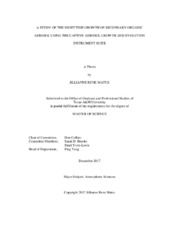| dc.description.abstract | Models that seek to calculate the effect of aerosol on climate must take into account both primary and secondary sources of aerosol, as well as the environmental conditions that may affect these populations such as ambient temperature, RH, UV intensity, and gas composition. These factors can prompt changes in the physical and chemical properties of the aerosols, affecting the way they contribute to climate change and interact with other atmospheric constituents. Recently, there has been particular interest in the aerosol that is formed from the combination of urban and rural air masses. Studies have shown that the interaction between biogenic volatile organic compounds (BVOC) and anthropogenic emissions is likely a major source of secondary organic aerosol (SOA). The unique ability to isolate factors contributing to SOA formation processes within the complex ambient environment allows the CAGE system to provide insight into anthropogenic impacts and guide related modeling and mitigation efforts. This research project aims to demonstrate the suitability of the new CAGE system for observing trends in particle growth rate. Experiments were performed in the W G Jones State Forest in the greater Houston metropolitan area, which provided a favorable location for observing aerosol production resulting from different concentrations of ambient gases. Particular focus will be on the growth and stability of particles formed during nighttime observations. It would be expected that SOA would lose mass as the concentration of gases that contribute to their formation decreases. However, multiple days of observation showed that this was not often the case, indicating that the aerosol formed was relatively stable and unaffected by perturbations in the concentration of atmospheric constituents. | en |


